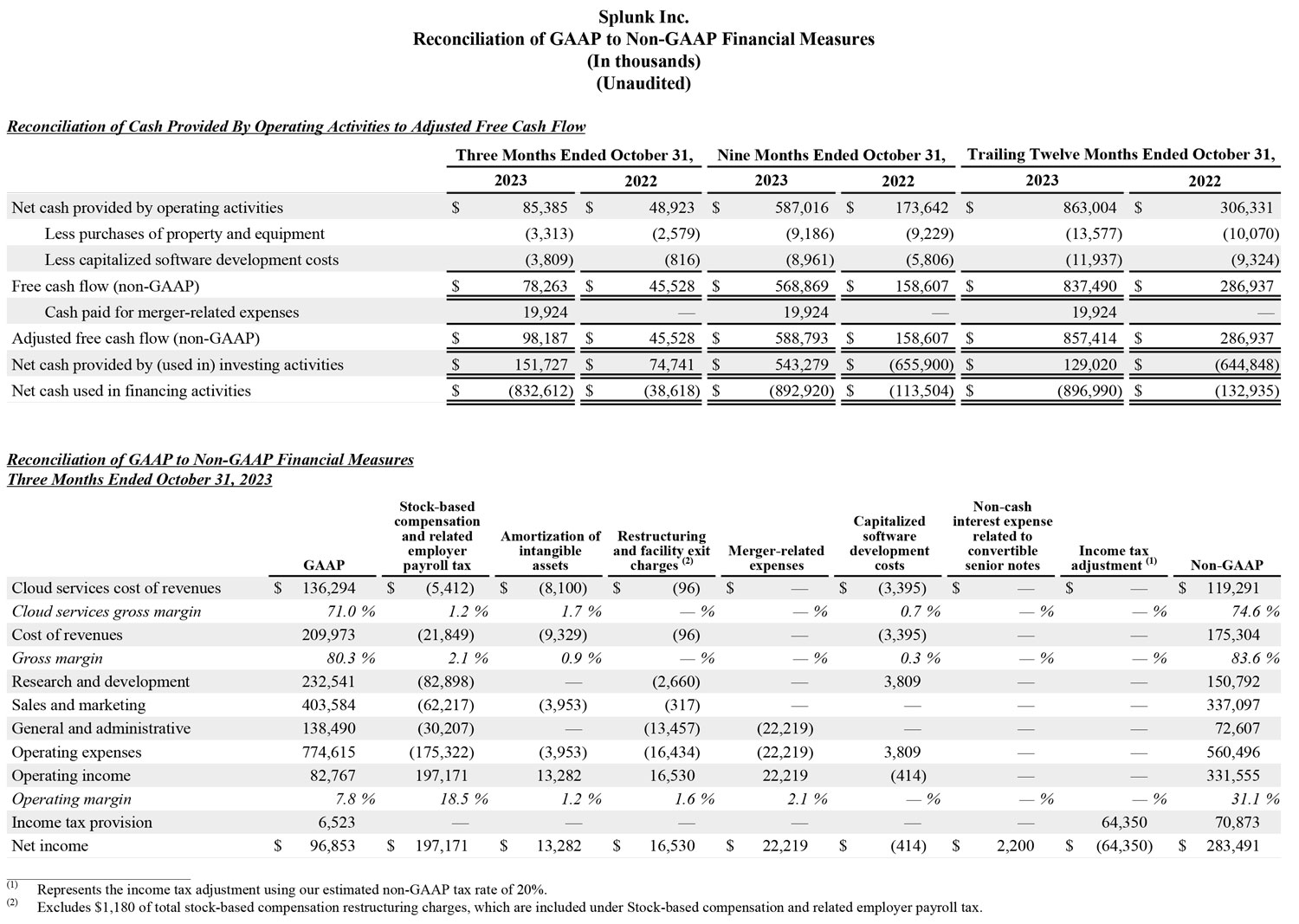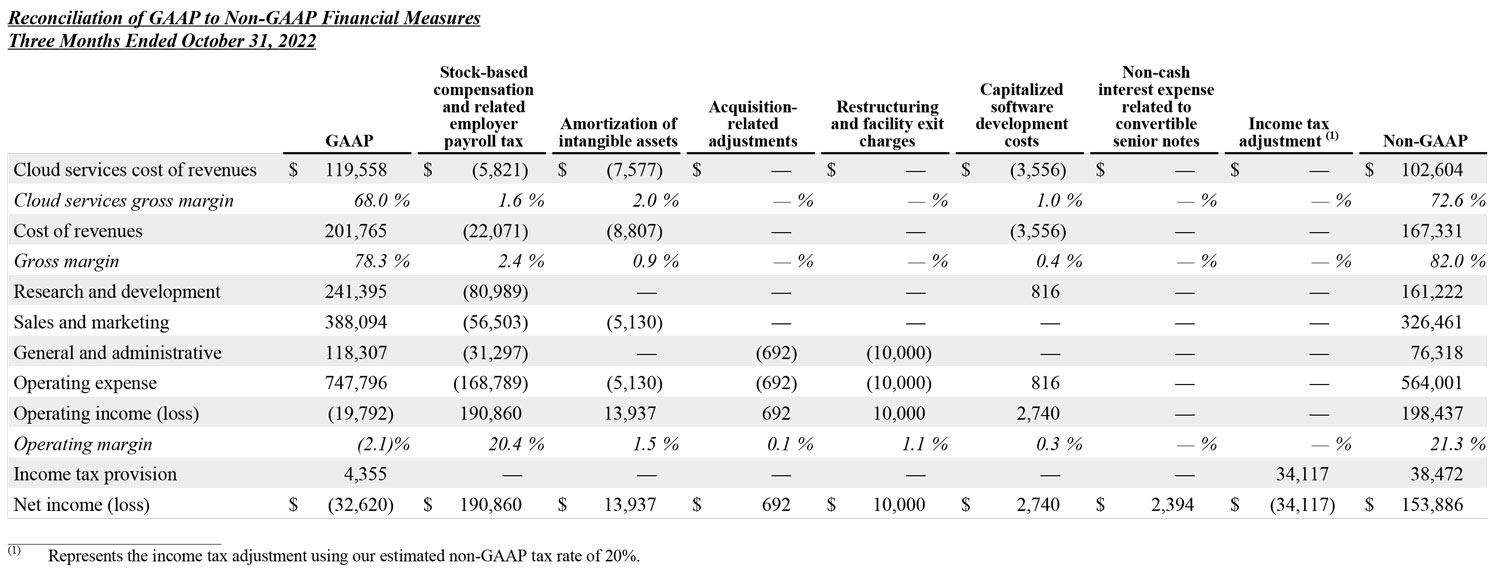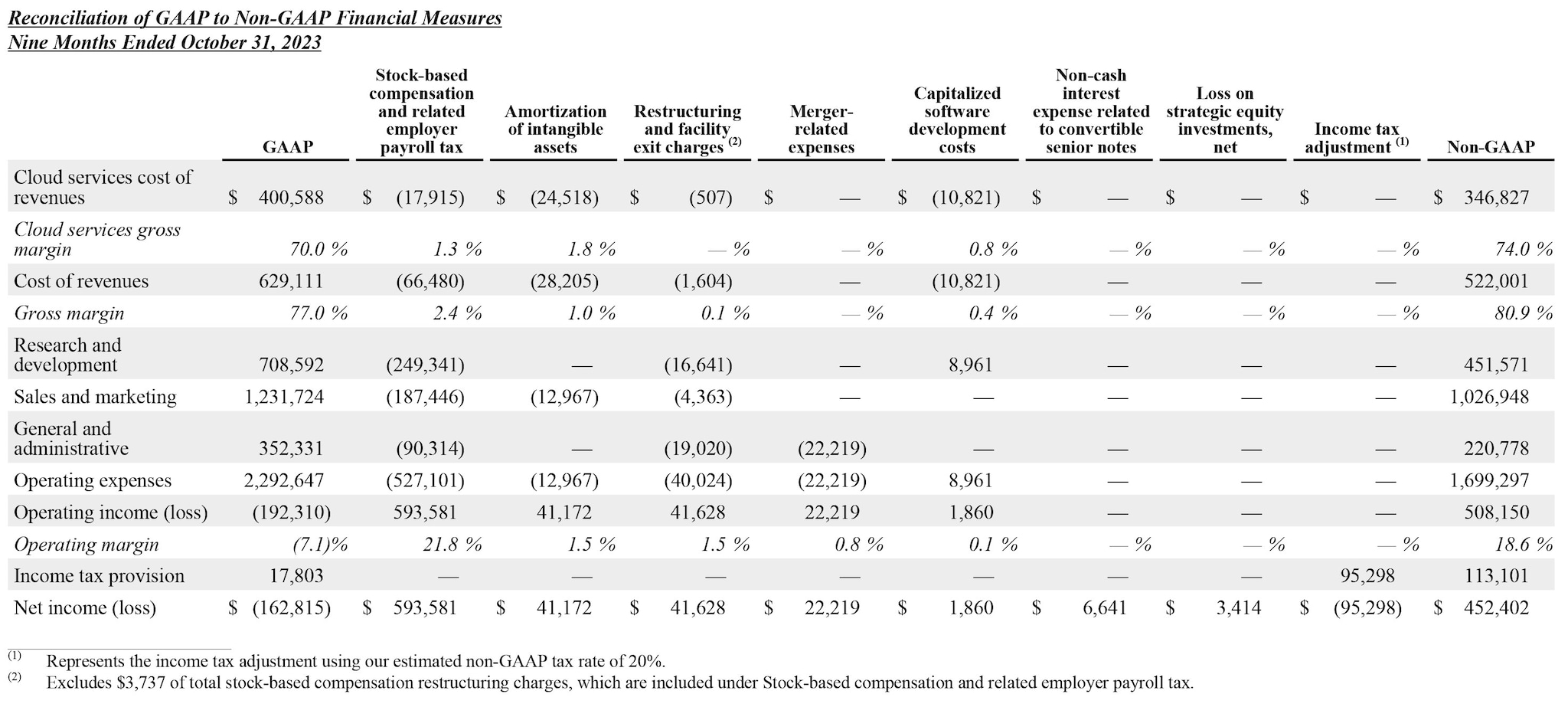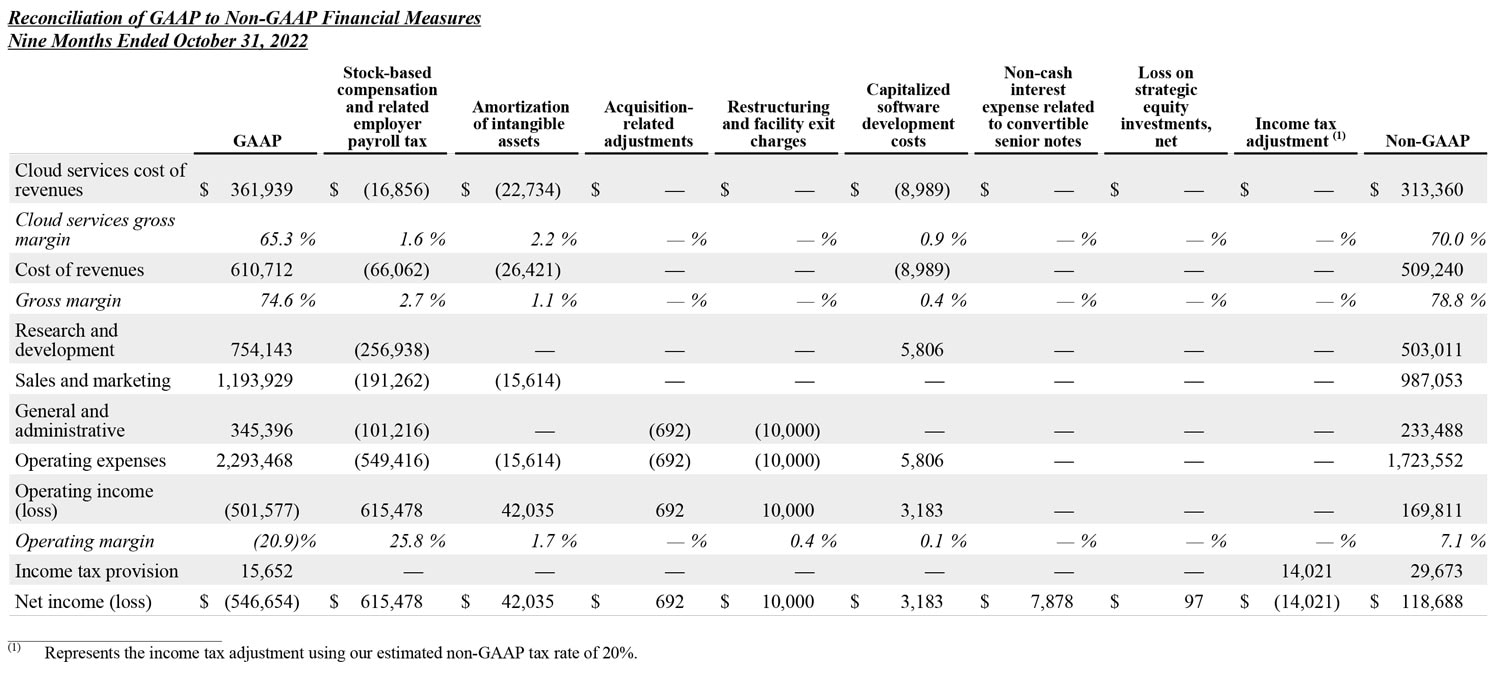November 28, 2023 – Splunk Inc. (NASDAQ: SPLK), the cybersecurity and observability leader, today announced results for its fiscal third quarter ended October 31, 2023.
Third Quarter 2024 Financial Highlights
- Total ARR was $4.0 billion, up 15% year-over-year.
- Total revenues were $1.067 billion, with Cloud revenue growing 26% to $469 million.
- GAAP Operating Expenses increased 4% year-over-year; non-GAAP Operating Expenses decreased by 1% year-over-year.
- Trailing twelve month operating cash flow was $863 million, up 182% year-over-year.
- Trailing twelve month adjusted free cash flow was $857 million, up 199% year-over-year.
- 851 customers with Total ARR greater than $1 million, an increase of 97 year-over-year.
"Splunk delivered a solid third quarter and marked several milestones in our journey to deliver exceptional customer and shareholder value, including our agreement to join forces with Cisco,” said Gary Steele, President and CEO of Splunk. “Organizations are continuing to unlock value with Splunk, and in Q3 we saw solid momentum in our cloud business as Cloud ARR grew 26% year-over-year and now represents the majority of Total ARR. Our results demonstrate our accelerated innovation, relentless customer focus and consistent execution, and I'm confident we are well-positioned for the future.”
“We remain focused on driving growth and increasing profitability and are pleased with our progress in Q3. We drove ARR growth of 15% to $4.0 billion, achieved a non-GAAP operating margin of 31% and generated nearly $100 million of GAAP net income,” said Brian Roberts, CFO of Splunk.
Recent Business Highlights
- Splunk Innovations Drive Digital Resilience: Splunk continued to accelerate innovation to further strengthen its industry-leading security and observability product portfolio to help customers keep their digital systems resilient. New enhanced capabilities include Splunk Enterprise Security 7.2, Splunk SOAR 6.1.1, Session Replay in Splunk Observability Cloud, Federated Search for Amazon S3 and Edge Processor advancements.
- Splunk Products Win “Best B2B Enterprise Technology” Awards: Resulting from customer reviews on PeerSpot, Splunk SOAR and Splunk Enterprise Security were recognized in four categories: Security Orchestration, Automation and Response (SOAR), Security Information and Event Management (SIEM), IT Operations Analytics and Log Management.
- Splunk Among Top Cybersecurity Leaders Celebrating First Anniversary of the Open Cybersecurity Schema Framework (OCSF) Project: OCSF, an open-source project that defines a common standard for cybersecurity data, announced the general availability of its vendor-agnostic security schema as part of its first anniversary.
- Splunk Releases 2023 CISO Report: Splunk published a new global research report detailing emerging trends, threats and strategies for today’s security leaders.
- Splunk Releases 2023 Global Impact Report: Splunk’s third annual Global Impact Report outlines its commitment to contributing to broader societal challenges and opportunities while supporting the durability and resilience of its business, and creating value for its stakeholders.
Third Quarter Investor Presentation and Stockholder Letter
Visit the Splunk investor relations website to download the company’s quarterly investor presentation, which includes Splunk President and CEO Gary Steele’s letter to stockholders. In light of the pending transaction with Cisco, Splunk will not be hosting an earnings conference call to review the third quarter or providing a financial outlook.
Additional Information and Where to Find It
In connection with the proposed transaction and required stockholder approval, Splunk filed with the SEC a definitive proxy statement on October 30, 2023. The proxy statement has been mailed to the stockholders of Splunk. This document is not a substitute for the proxy statement or any other document which Splunk may file with the SEC. Splunk’s stockholders are urged to carefully read the proxy statement (including all amendments, supplements and any documents incorporated by reference therein) and other relevant materials filed or to be filed with the SEC and in their entirety because they contain important information about the proposed transaction and the parties to the transaction. Investors may obtain free copies of these documents and other documents filed with the SEC at its website at www.sec.gov. In addition, investors may obtain free copies of the documents filed with the SEC by Splunk by going to Splunk’s Investor Relations page on its corporate website at https://investors.splunk.com or by contacting Splunk Investor Relations at ir@splunk.com.
Participants in the Solicitation
Splunk and its executive officers and directors may be deemed to be participants in the solicitation of proxies from Splunk’s stockholders with respect to the transaction. Information about Splunk’s directors and executive officers, including their ownership of Splunk securities, is set forth in the definitive proxy statement related to the transaction, which was filed with the SEC on October 30, 2023, proxy statement for Splunk’s 2023 Annual Meeting of Stockholders, which was filed with the SEC on May 9, 2023, Form 8-K filed with the SEC on September 21, 2023, and Splunk’s other filings with the SEC. Investors may obtain more detailed information regarding the direct and indirect interests of Splunk and its respective executive officers and directors in the transaction, which may be different than those of Splunk stockholders generally, by reading the definitive proxy statement regarding the transaction, which was filed with the SEC.
Safe Harbor Statement
This press release contains forward-looking statements that involve risks and uncertainties, including statements regarding Splunk’s positioning for the future; Splunk’s proposed acquisition by Cisco and the benefits of the acquisition; trends in customer demand and engagement; statements regarding our operating efficiency, growth, profitability and cash flows; statements regarding our products, projects, technology and ongoing product development, including recently announced products; statements regarding our partnerships; statements regarding our market opportunity as well as our ability to meet customer needs; and trends in the markets for our products, including the security and observability markets. There are a significant number of factors that could cause actual results to differ materially from statements made in this press release, including: the risk that the proposed transaction with Cisco is not completed on the anticipated terms or in the time anticipated, including risks related to obtaining shareholder and regulatory approvals, anticipated tax treatment, unforeseen liabilities, future capital expenditures, revenues, expenses, earnings, synergies, economic performance, indebtedness, financial condition, losses, future prospects, business and management strategies for the management, expansion and growth of Splunk’s business and other conditions to the completion of the transaction; significant transaction costs associated with the proposed transaction; potential litigation relating to the proposed transaction; the risk that disruptions from the proposed transaction will harm Splunk’s business, including current plans and operations; the ability of Splunk to implement its business strategy; the impact of the macroeconomic environment, including inflationary pressures, economic uncertainty and impacts on information technology spending; risks associated with Splunk’s growth; the impact of Splunk’s restructuring plans; risks associated with Splunk’s ability to successfully introduce and gain market acceptance for new products and technologies; Splunk’s inability to realize value from its significant investments in the company’s business, including product and service innovations and through acquisitions; Splunk’s shift from sales of licenses to sales of cloud services which impacts the timing of revenue and margins; Splunk’s transition to a multi-product software and services business; Splunk’s inability to successfully integrate acquired businesses and technologies; Splunk’s inability to service its debt obligations or other adverse effects related to the company’s convertible notes; and general market, political, economic, business and competitive market conditions.
Additional information on potential factors that could affect Splunk’s financial results is included in the company’s Quarterly Report on Form 10-Q for the fiscal quarter ended July 31, 2023, which is on file with the U.S. Securities and Exchange Commission (“SEC”) and Splunk’s other filings with the SEC. Splunk does not assume any obligation to update the forward-looking statements provided to reflect events that occur or circumstances that exist after the date on which they were made.
Splunk Inc. (NASDAQ: SPLK) helps build a safer and more resilient digital world. Organizations trust Splunk to prevent security, infrastructure and application issues from becoming major incidents, absorb shocks from digital disruptions, and accelerate digital transformation.
Splunk, Splunk>, and Turn Data Into Doing are trademarks and registered trademarks of Splunk Inc. in the United States and other countries. All other brand names, product names, or trademarks belong to their respective owners. © 2023 Splunk Inc. All rights reserved.
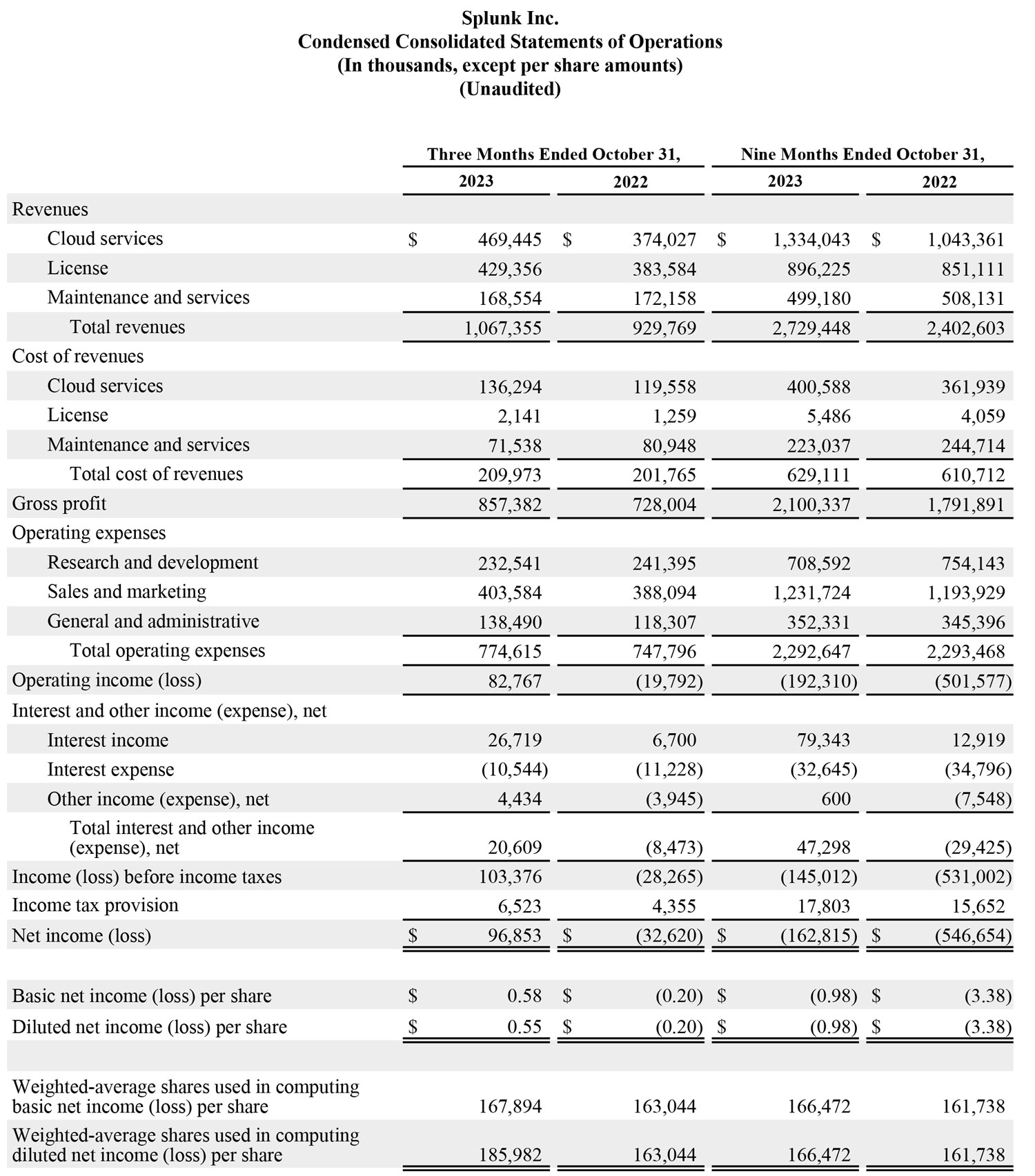
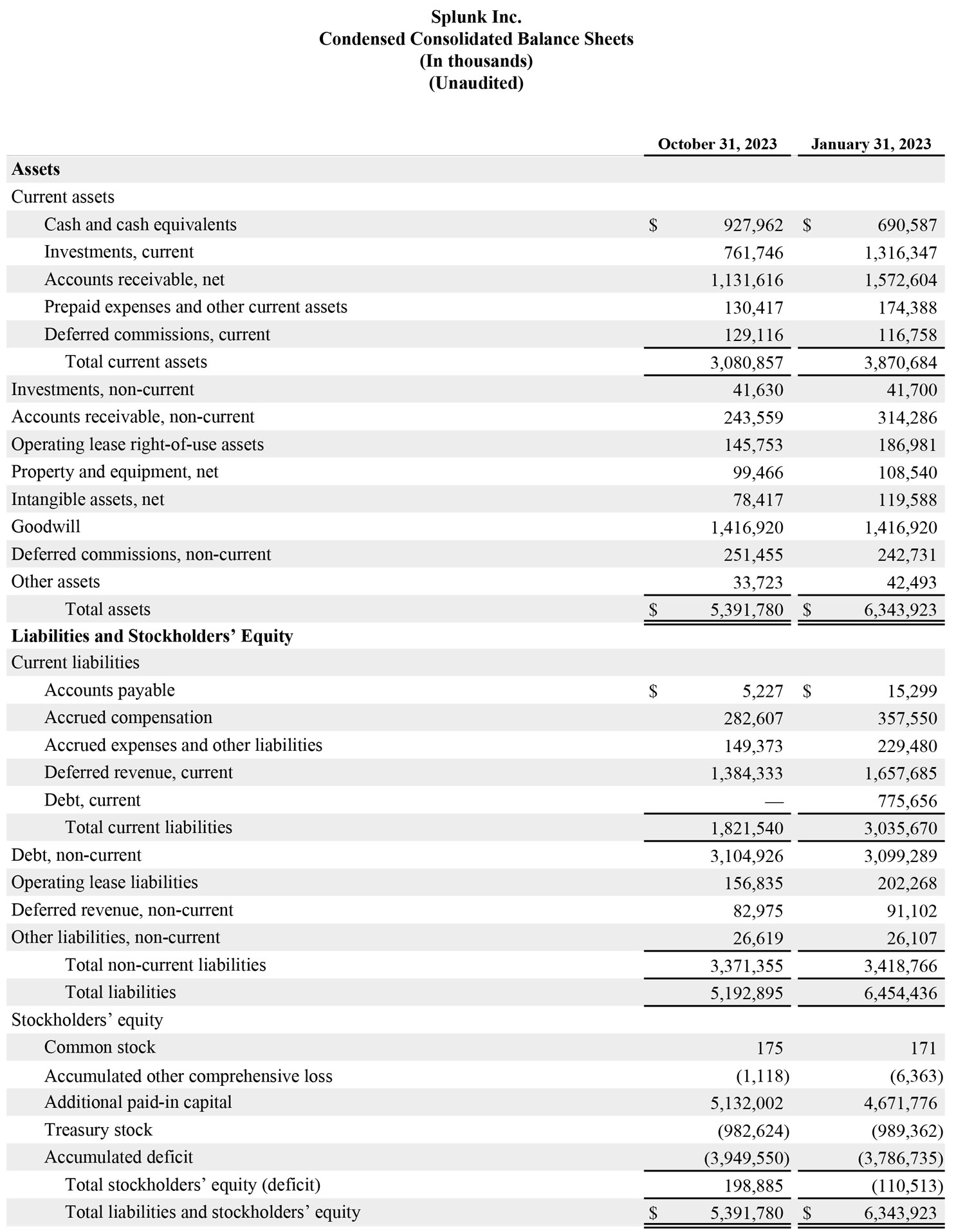
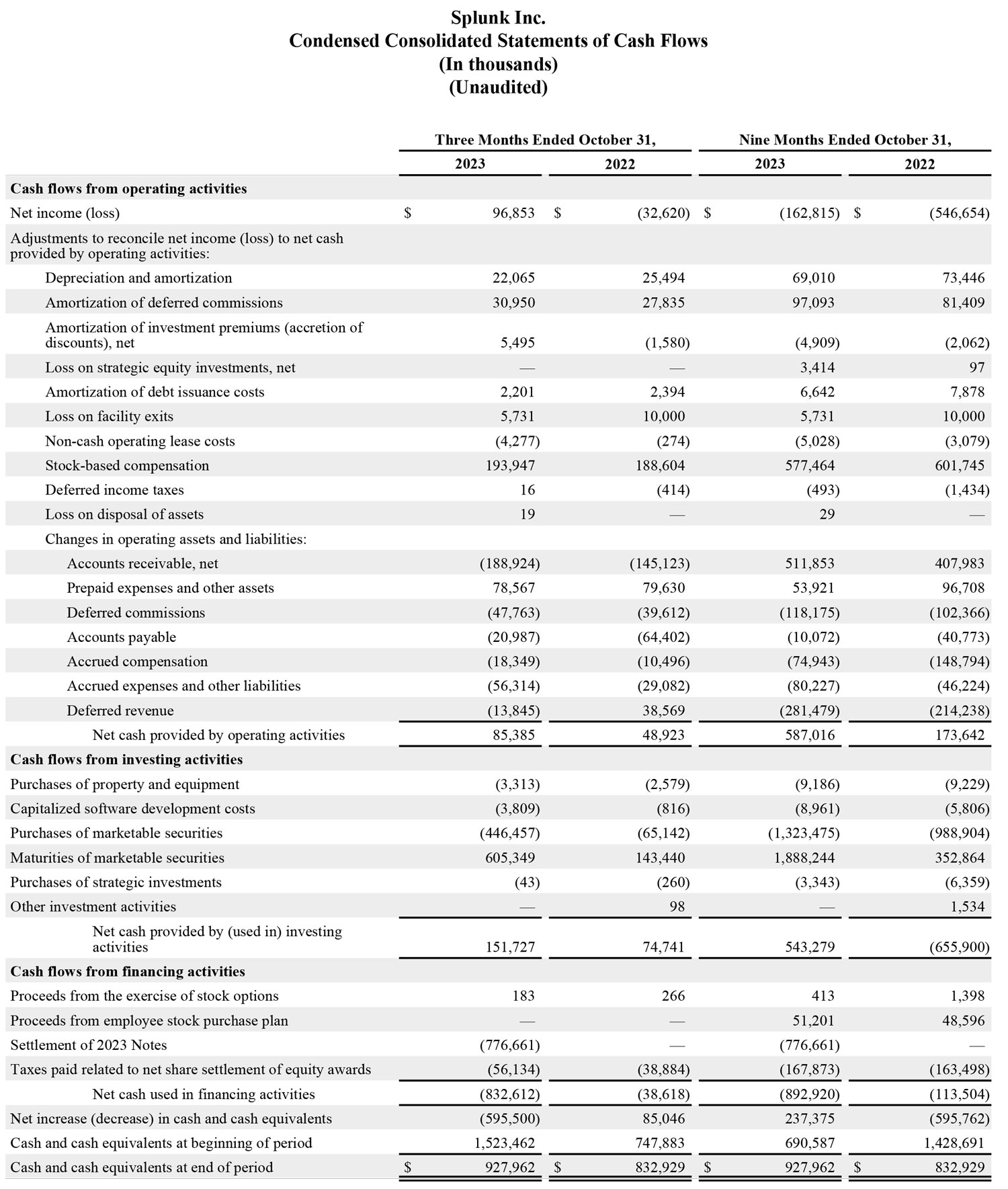
Splunk Inc.
Operating Metrics
Total Annual Recurring Revenue (“Total ARR”) represents the annualized value of active cloud services, term licenses and maintenance contracts at the end of a reporting period. Cloud Annual Recurring Revenue (“Cloud ARR”) represents the annualized value of active cloud services contracts at the end of a reporting period.
Non-GAAP Financial Measures and Reconciliations
To supplement Splunk’s unaudited interim condensed consolidated financial statements, which have been prepared in accordance with generally accepted accounting principles in the United States (“GAAP”) and applicable rules and regulations of the Securities and Exchange Commission regarding interim financial reporting, Splunk provides investors with the following non-GAAP financial measures: cloud services cost of revenues, cloud services gross margin, cost of revenues, gross margin, research and development expense, sales and marketing expense, general and administrative expense, operating expenses, operating income (loss), operating margin, income tax provision (benefit), net income (loss), free cash flow and adjusted free cash flow (collectively the “non-GAAP financial measures”). These non-GAAP financial measures exclude all or a combination of the following (as reflected in the following reconciliation tables): expenses related to stock-based compensation and related employer payroll tax, amortization of intangible assets, restructuring and facility exit charges, merger-related expenses, capitalized software development costs, non-cash interest expense related to convertible senior notes and a net loss (gain) on strategic equity investments. The non-GAAP financial measures are also adjusted for Splunk's current and deferred tax rate on non-GAAP income (loss). Splunk uses a long-term projected non-GAAP tax rate to provide consistency across interim reporting periods. We base our rate on non-GAAP financial projections. In determining our tax rate, we exclude the impact of nonrecurring items, and we make assumptions including those about tax legislation and our tax positions. We applied a 20% non-GAAP tax rate to the three and nine months ended October 31, 2023 and 2022. In addition, non-GAAP financial measures include free cash flow and adjusted free cash flow. Free cash flow represents net cash provided by operating activities, less purchases of property and equipment and capitalized software development costs. Adjusted free cash flow is a non-GAAP measure that additionally excludes from free cash flow the impact of cash paid for costs incurred as a result of the proposed Cisco merger. Splunk believes that free cash flow and adjusted free cash flow provide investors useful information to better understand the factors and trends affecting the Company’s performance and liquidity. Both of these free cash flow measures have limitations as they omit certain components of the overall cash flow statement and do not represent the residual cash flow available for discretionary expenditures.
Splunk excludes stock-based compensation expense because it is non-cash in nature and excluding this expense provides meaningful supplemental information regarding Splunk’s operational performance and allows investors the ability to make more meaningful comparisons between Splunk’s operating results and those of other companies. Splunk excludes employer payroll tax expense related to employee stock plans in order for investors to see the full effect that excluding that stock-based compensation expense had on Splunk’s operating results. Employer payroll tax expense is tied to the exercise or vesting of underlying equity awards and the price of Splunk’s common stock at the time of vesting or exercise, which may vary from period to period independent of the operating performance of Splunk’s business. Splunk also excludes amortization of intangible assets, restructuring and facility exit charges, merger-related expenses, capitalized software development costs, non-cash interest expense related to convertible senior notes and a net loss (gain) on strategic equity investments from the applicable non-GAAP financial measures because these adjustments are considered by management to be outside of Splunk’s core operating results. A reconciliation of non-GAAP guidance measures to corresponding GAAP guidance measures is not available on a forward-looking basis without unreasonable effort due to the uncertainty regarding, and the potential variability of, expenses that may be incurred in the future. For example, stock-based compensation-related charges, including related employer payroll tax-related items, are impacted by the timing of employee stock transactions, the future fair market value of our common stock, and our future hiring and retention needs, all of which are difficult to predict and subject to constant change. We have provided a reconciliation of GAAP to non-GAAP financial measures in the financial statement tables for our historical non-GAAP financial results included in this release.
There are limitations in using non-GAAP financial measures because the non-GAAP financial measures are not prepared in accordance with GAAP, may be different from non-GAAP financial measures used by Splunk’s competitors and exclude expenses that may have a material impact upon Splunk’s reported financial results. Further, stock-based compensation expense has been and will continue to be for the foreseeable future, a significant recurring expense in Splunk’s business and an important part of the compensation provided to Splunk’s employees. The presentation of the non-GAAP financial measures is not intended to be considered in isolation or as a substitute for, or superior to, the financial information prepared and presented in accordance with GAAP. Splunk uses these non-GAAP financial measures for financial and operational decision-making purposes and as a means to evaluate period-to-period comparisons. Splunk believes that these non-GAAP financial measures provide useful information about Splunk’s operating results, enhance the overall understanding of past financial performance and future prospects and allow for greater transparency with respect to key metrics used by management in its financial and operational decision making. In addition, these non-GAAP financial measures facilitate comparisons to competitors’ operating results. The non-GAAP financial measures are meant to supplement and be viewed in conjunction with GAAP financial measures.
The following tables reconcile Splunk’s GAAP results to Splunk’s non-GAAP results included in this press release.
